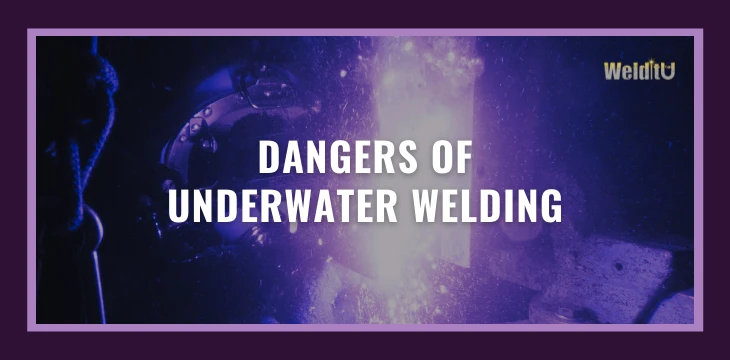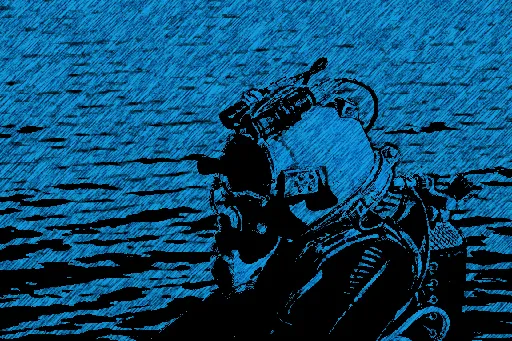Why is underwater welding so dangerous?
The main underwater welding dangers include electrocution, drowning, gas toxicity, and other effects of extreme pressure.
Underwater Welding Dangers
The dangers of underwater welding require operators to be skilled at both welding and commercial diving. Before picking up a mask, professional training for welding or diving focuses on the risks and the importance of safety.
They’re instructed to always follow safety protocols, maintain focus on the task at hand, and minimize distractions. Lack of attention increases the risk of injury or death for welders and divers.
But combine these activities into one and the dangers multiply. Water welding forces the worker to split their focus between two risky activities, each requiring full operator attention for maximum safety. It becomes impossible to give 100% attention to both welding and diving at the same time.
This is why underwater welding is so dangerous.

Specific Underwater Welding Hazards
Electrocution
One of the biggest dangers to welders is electrocution. Because electricity travels easily through water, welding equipment must be adapted for safe use.
Proper equipment is insulated, used with a waterproof electrode, and regularly inspected to avoid electric shock.
Wet underwater welding means physically working in the water. But even dry underwater welding performed in a pressurized hyperbaric welding chamber occurs under extremely humid and damp conditions.
They do not use AC welders in wet welding because exposure to alternating current can lock up hand muscles, preventing the welder from quickly dropping the faulty equipment.
Working topsides, an assistant controls the main power and energizes the circuit only when the electrode is in contact with the work surface.
Explosion
Underwater welding creates hydrogen and oxygen gas. This explosive combination can bubble up and collect in pockets, which should be vented away.
Gas Toxicity
Even the components of the air we breathe and consider safe can have toxic effects during deep dives.
Oxygen toxicity
An underwater welder using an incorrect concentration of oxygen during dives over 187 feet is at risk of oxygen toxicity. Symptoms include tingling, twitching, vertigo, nausea and vomiting, and tunnel vision. Special gas mixtures and advanced training are required.
Nitrogen narcosis
Also known as “rapture of the deep,” nitrogen narcosis resembles alcohol intoxication. Becoming noticeable at 100-foot depths, divers show poor judgment and may become euphoric. The effect can be avoided by replacing regular air with a special blend for deeper dives.

Carbon dioxide toxicity
A buildup of carbon dioxide in the blood can cause:
- Headaches
- Difficulty breathing
- Nausea
- Vomiting
- Flushing
- Blackouts
Carbon dioxide toxicity occurs when a diver’s respiration rate doesn’t increase enough during exertion, or enough to move the denser air through the breathing apparatus.
Carbon monoxide poisoning
A faulty onboard breathing air compressor can introduce carbon monoxide. Mild symptoms of carbon monoxide poisoning include nausea, headache, weakness, clumsiness, and confusion.
Seizures, loss of consciousness, or coma occur in severe cases.
High-pressure nervous syndrome
Rapid, deep dives of 500 feet or more may cause nausea, vomiting, tremors, clumsiness, dizziness, fatigue, sleepiness, muscle jerks, stomach cramps, and confusion.
Effects of Extreme Pressure
At sea level, the air pressure on our bodies equals 14.7 psi or one atmosphere. This pressure increases by one atmosphere for every 10 meters of depth, having an increasingly dangerous effect on the body of a welder working underwater.
Arterial Gas Embolism
Increased pressure forces gas bubbles into heart or lung arteries. The rapid onset of symptoms includes extreme tiredness, poor coordination, difficulty concentrating, tremors, nausea, and bloody saliva.

Decompression Sickness (Type I)
Water pressure forces nitrogen out of the bloodstream into bubbles that accumulate in the joints. If a diver returns to the surface slowly, the body will naturally reabsorb these bubbles. But rise too quickly and the nitrogen bubbles will expand in place, causing fatigue and pain in muscles and joints. Known as The Bends, extreme cases resemble a stroke.
Decompression Sickness (Type II)
With symptoms beyond The Bends, Type II decompression sickness affects neurological function, including vision, balance, memory, and causes strange behavior. In severe cases, shortness of breath may be followed by cardiopulmonary failure.
Drowning
Because any illness or underwater welding accident can cause drowning, it is the most frequent cause of diving deaths.
Welders may experience a diving gear failure or become entangled in underwater structures.
Where water moves from an area of high pressure to one of low pressure, an underwater welder will encounter differential pressure hazards. This is common near locks, dams, canals, water tanks, pipelines, other hollow structures, and around ships.
Hypothermia
Although commercial divers wear insulated suits when working in cold water, long exposure may cause their body to lose heat faster than it’s produced, resulting in hypothermia. Early symptoms include:
- Shivering
- Exhaustion
- Confusion
- Loss of coordination
- Memory loss
- Slurred speech
- Drowsiness
A diver experiencing any of the above signs, with a body temperature below 95° F, needs immediate medical attention. Unconsciousness and death will occur without treatment.
Health Issues
Underwater welding can be strenuous and put a lot of strain on your body. Keep yourself in fit condition and talk to your doctor if you have heart, lung, breathing, blood pressure, or other pre-existing health issues.
Video: The dangerous world of underwater welding (5 min.)
If it is so dangerous, why choose a career as an underwater welder?
Shipbuilding and repair, offshore oil platforms, and undersea pipelines are just a few industries that rely on underwater welders. Welding underwater is a skill set that few can master. It’s often commercial divers, later trained to become welders.
Along with the dangers, diving and welding school costs can be high, but it’s a skill that’s hard to replace with robots and salaries remain high.
It takes proper training, practice, and preparation to reduce underwater welding risks. It’s critical to maintain physical and mental fitness, and never work alone.

